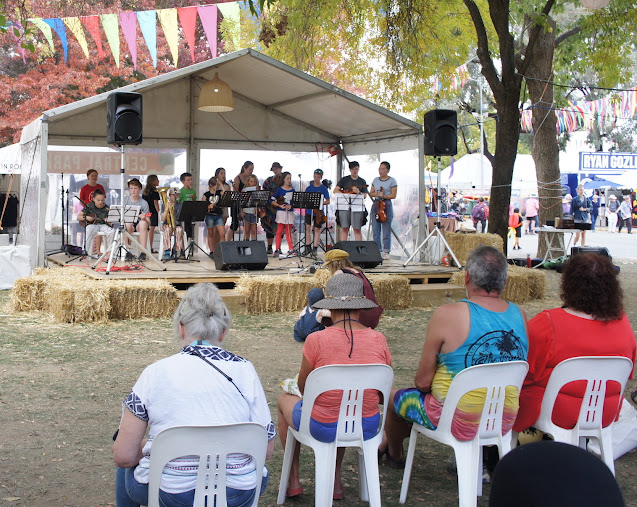Report on Colonial Ball & a few other dances 2019 National Folk Festival
Report on Dennis O'Keeffe Memorial Aussie Songs session @NFF19
Report on other events at NFF19
Report by Saplings Coordinator, Helen Romeo
Photos © Sandra Nixon


1. Sam & Beck

2.

3. Helen

4. Vanessa

5. Real bones supplied by Tony's butcher!

6. Tony

7.

8. Dave

9. Beck & Dave

10.

11.

12.

13.

14.

15.

16.

17.Vanessa & Helen

18. Beck

19.

20.

21. Tony

22. Chris

23.

24.

25. Steve

26.

27. Sam

28.

29.

30.

31.

32. Dave

33. Tony

34. Steve, Beck, Dave

35.

36.

37.

38. The traditional group photo

39. The traditional silly photo!
***************************************
We
had at least 20 musicians and singers turn up during our Easter Sapling
Sessions at the National. It was a great weekend and we had a
wonderful group of young people, mostly new to Saplings, to learn some
of our Australian Traditional songs and tunes. On the Monday, those who
were still at the festival, performed 8 tunes and 3 songs .... a
sterling performance, enjoyed by all. Well done!
Thank
you to all parents who encourage their children with their music and
thank you to the tutors who have a love of our Australian tradition and
are willing to pass it on to the young. Our tutors at the National were: Samantha O'Brien on flute, Tony Romeo on percussion, Steve Lockwood on
banjo, Vanessa Lockwood and Dave Johnson on fiddle, Chris Poleson on
uke, guitar and mouthorgan, and Beck Richmond and myself (Helen Romeo) on
English concertina with our BMC Secretary, Sandra Nixon taking photos
and talking to parents!


Photos © Sandra Nixon


1. Sam & Beck

2.

3. Helen

4. Vanessa

5. Real bones supplied by Tony's butcher!

6. Tony

7.

8. Dave

9. Beck & Dave

10.

11.

12.

13.

14.

15.

16.

17.Vanessa & Helen

18. Beck

19.

20.

21. Tony

22. Chris

23.

24.

25. Steve

26.

27. Sam

28.

29.

30.

31.

32. Dave

33. Tony

34. Steve, Beck, Dave

35.

36.

37.

38. The traditional group photo

39. The traditional silly photo!
***************************************















